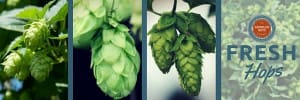 Summer is winding down and with that comes the harvest of hops all over the Pacific Northwest. In most cases, the hops are dried and then sold to breweries and home brewers but over the past few years, fresh hop beers have become a sensation among craft beer lovers and brewers themselves. Here are some fun tidbits about this beloved seasonal beer variety that is truly a labor of love of the hop plant. Why are they called fresh hop or wet hop beers? Simply, the hop flowers are taken off the vine and immediately brewed within 24-hours instead of being processed. It’s similar to when cooking with fresh herbs versus dried herbs. When the hops are dried, the less flavor the hops have making fresh hop beer usually more flavorful and hoppy than other craft beers. Also after 24 hours, the hops start to lose their flavor and compost, so time is of the essence. This method caught on despite the logistical nightmare and coordination between hop grower and brewer, with harvest, delivery and brewing all done over a 24 hours period. If the brewer is not close to the fresh hops, they have to fly thehops overnight to meet the 24-hour deadline. Many breweries now grow hops on-site to bypass the process of driving to pick up the hops or being delivered by plane. As for style of beer, they are primarily brewed using a simple pale ale or IPA recipe with grain bills simple, keeping with the pale ale/IPA theme which showcase the hops in optimal wet condition. Fresh Hop beers usually range from 5 to 7 percent ABV, with IBU ratings from 35 to 70, and from modestly to fully hopped out brews. Sierra Nevada was the first to introduce a fresh hop ale commercially with their Harvest Ale in 1996. A huge success, Harvest Ale became a seasonal. Now there are countless fresh hop craft beers and festivals that revolve around the brewed style. Chris Nemlowill, co-owner of Astoria, Oregon’s Fort George Brewery explained their process to Bon Appetit in an issue last summer:
Summer is winding down and with that comes the harvest of hops all over the Pacific Northwest. In most cases, the hops are dried and then sold to breweries and home brewers but over the past few years, fresh hop beers have become a sensation among craft beer lovers and brewers themselves. Here are some fun tidbits about this beloved seasonal beer variety that is truly a labor of love of the hop plant. Why are they called fresh hop or wet hop beers? Simply, the hop flowers are taken off the vine and immediately brewed within 24-hours instead of being processed. It’s similar to when cooking with fresh herbs versus dried herbs. When the hops are dried, the less flavor the hops have making fresh hop beer usually more flavorful and hoppy than other craft beers. Also after 24 hours, the hops start to lose their flavor and compost, so time is of the essence. This method caught on despite the logistical nightmare and coordination between hop grower and brewer, with harvest, delivery and brewing all done over a 24 hours period. If the brewer is not close to the fresh hops, they have to fly thehops overnight to meet the 24-hour deadline. Many breweries now grow hops on-site to bypass the process of driving to pick up the hops or being delivered by plane. As for style of beer, they are primarily brewed using a simple pale ale or IPA recipe with grain bills simple, keeping with the pale ale/IPA theme which showcase the hops in optimal wet condition. Fresh Hop beers usually range from 5 to 7 percent ABV, with IBU ratings from 35 to 70, and from modestly to fully hopped out brews. Sierra Nevada was the first to introduce a fresh hop ale commercially with their Harvest Ale in 1996. A huge success, Harvest Ale became a seasonal. Now there are countless fresh hop craft beers and festivals that revolve around the brewed style. Chris Nemlowill, co-owner of Astoria, Oregon’s Fort George Brewery explained their process to Bon Appetit in an issue last summer: Fort George has to shut down half the brewery for a week. And wait. And wait. When the call came, Nemlowil hopped in a 16-foot truck and drove four-plus hours east to Yakima, Washington’s B.T. Loftus Ranches. He filled the truck with 2,200 pounds of Simcoe hops and returned to Astoria, arriving around midnight. By 5 a.m., the brewers were at work. They didn’t stop brewing for more than a day. Sure, the process is a pain in the butt. But the payoff is that “you’re getting the true hop flavor,” Nemlowill says of the piney, earthy, and aptly named Fresh IPA. (http://www.bonappetit.com/drinks/beer/article/fresh-hops) With the hop harvest done by now, we are now ready to taste these vibrant, hoppy brews fresh from the taps and our growlers.

What the heck is a crowler?